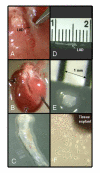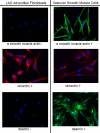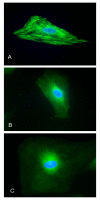A cell culture model using rat coronary artery adventitial fibroblasts to measure collagen production
- PMID: 17488510
- PMCID: PMC1885448
- DOI: 10.1186/1471-2261-7-13
A cell culture model using rat coronary artery adventitial fibroblasts to measure collagen production
Abstract
Background: We have developed a rat cell model for studying collagen type I production in coronary artery adventitial fibroblasts. Increased deposition of adventitial collagen type I leads to stiffening of the blood vessel, increased blood pressure, arteriosclerosis and coronary heart disease. Although the source and mechanism of collagen deposition is yet unknown, the adventitia appears to play a significant role. To demonstrate the application of our cell model, cultured adventitial fibroblasts were treated with sex hormones and the effect on collagen production measured.
Methods: Hearts (10-12 weeks) were harvested and the left anterior descending coronary artery (LAD) was isolated and removed. Tissue explants were cultured and cells (passages 2-4) were confirmed as fibroblasts using immunohistochemistry. Optimal conditions were determined for cell tissue harvest, timing, proliferation and culture conditions. Fibroblasts were exposed to 10-7 M testosterone or 10-7 M estrogen for 24 hours and either immunostained for collagen type I or subjected to ELISA.
Results: Results showed increased collagen staining in fibroblasts treated with testosterone compared to control and decreased staining with estrogen. ELISA results showed that testosterone increased collagen I by 20% whereas estrogen decreased collagen I by 15%.
Conclusion: Data demonstrates the usefulness of our cell model in studying the specific role of the adventitia apart from other blood vessel tissue in rat coronary arteries. Results suggest opposite effects of testosterone and estrogen on collagen synthesis in the rat coronary artery adventitial fibroblasts.
Figures




Similar articles
-
Peroxisome proliferator-activated receptor-gamma agonists attenuate angiotensin II-induced collagen type I expression in adventitial fibroblasts.Clin Exp Pharmacol Physiol. 2008 Jan;35(1):72-7. doi: 10.1111/j.1440-1681.2007.04748.x. Clin Exp Pharmacol Physiol. 2008. PMID: 18047631
-
Urotensin II induces phenotypic differentiation, migration, and collagen synthesis of adventitial fibroblasts from rat aorta.J Hypertens. 2008 Jun;26(6):1119-26. doi: 10.1097/HJH.0b013e3282fa1412. J Hypertens. 2008. PMID: 18475149
-
[Effect of vanadate on proliferation and collagen production of medial collateral ligament fibroblasts].Zhongguo Xiu Fu Chong Jian Wai Ke Za Zhi. 2008 Oct;22(10):1189-92. Zhongguo Xiu Fu Chong Jian Wai Ke Za Zhi. 2008. PMID: 18979875 Chinese.
-
Adventitial fibroblast reactive oxygen species as autacrine and paracrine mediators of remodeling: bellwether for vascular disease?Cardiovasc Res. 2007 Sep 1;75(4):679-89. doi: 10.1016/j.cardiores.2007.06.016. Epub 2007 Jun 22. Cardiovasc Res. 2007. PMID: 17689510 Review.
-
[Collagen formation of cultured cells (author's transl)].Tanpakushitsu Kakusan Koso. 1979;24(5):680-90. Tanpakushitsu Kakusan Koso. 1979. PMID: 224418 Review. Japanese. No abstract available.
Cited by
-
FSP1(+) fibroblast subpopulation is essential for the maintenance and regeneration of medullary thymic epithelial cells.Sci Rep. 2015 Oct 8;5:14871. doi: 10.1038/srep14871. Sci Rep. 2015. PMID: 26445893 Free PMC article.
-
Mechanobiological model of arterial growth and remodeling.Biomech Model Mechanobiol. 2018 Feb;17(1):87-101. doi: 10.1007/s10237-017-0946-y. Epub 2017 Aug 19. Biomech Model Mechanobiol. 2018. PMID: 28823079 Free PMC article.
-
Alterations in vasomotor systems and mechanics of resistance-sized mesenteric arteries from SHR and WKY male rats following in vivo testosterone manipulation.Biol Sex Differ. 2012 Jan 3;3(1):1. doi: 10.1186/2042-6410-3-1. Biol Sex Differ. 2012. PMID: 22214247 Free PMC article.
-
Reversible effect of castration induced hypogonadism on the morphology of the left coronary arteries in adult male rabbits.Anat Cell Biol. 2024 Mar 31;57(1):61-69. doi: 10.5115/acb.23.196. Epub 2023 Nov 30. Anat Cell Biol. 2024. PMID: 38030134 Free PMC article.
-
Transcriptome analysis reveals the regulatory mechanism of myofiber development in male and female black Muscovy duck at different ages.Front Vet Sci. 2024 Nov 20;11:1484102. doi: 10.3389/fvets.2024.1484102. eCollection 2024. Front Vet Sci. 2024. PMID: 39634756 Free PMC article.
References
-
- Tsuruda T, Kato J, Matsui E, Hatakeyama K, Masuyama H, Imamura T, Kitamura K, Asada Y, Eto T. Adrenomedullin alleviates not only neointimal formation but also perivascular hyperplasia following arterial injury in rats. Eur J Pharmacol. 2005;508:201–204. doi: 10.1016/j.ejphar.2004.12.019. - DOI - PubMed
-
- Li GH, Chen SJ, Oparil S, Chen YF, Thompson JA. Direct in vivo evidence demonstrating neointimal migration of adventitial fibroblasts after balloon injury of rat carotid arteries. Circulation. 2000;101:1362–1365. - PubMed
Publication types
MeSH terms
Substances
LinkOut - more resources
Full Text Sources
Other Literature Sources

